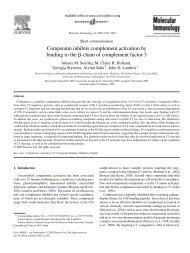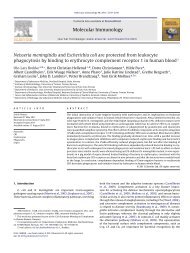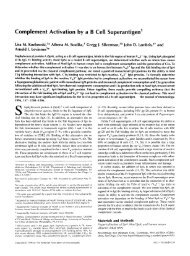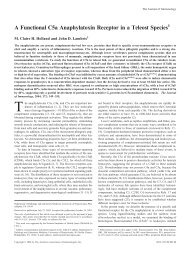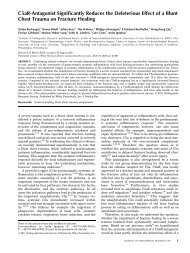Hydrophobic Effect and Hydrogen Bonds Account for the Improved ...
Hydrophobic Effect and Hydrogen Bonds Account for the Improved ...
Hydrophobic Effect and Hydrogen Bonds Account for the Improved ...
Create successful ePaper yourself
Turn your PDF publications into a flip-book with our unique Google optimized e-Paper software.
4620 Journal of Medicinal Chemistry, 2006, Vol. 49, No. 15 Katragadda et al.<br />
Figure 4. Plots showing <strong>the</strong> relationship between hydrophobicity of<br />
<strong>the</strong> analogues at position 4, denoted by log P, <strong>and</strong> <strong>the</strong> inhibitory constant<br />
(A), <strong>the</strong> binding constant (B), <strong>and</strong> entropy, denoted by -T∆S (C).<br />
electron-donating nature, as has been demonstrated <strong>for</strong> <strong>the</strong><br />
structure of <strong>the</strong> tetradeca(3-fluorotyrosyl)glutathione transferase.<br />
20 This possibility would more likely fit our observations,<br />
as <strong>the</strong> energy of <strong>the</strong> hydrogen bond is about 2 kcal/mol.<br />
However, <strong>the</strong> magnitude is twice <strong>the</strong> hydrogen-bond energy.<br />
One possible explanation is that a water molecule is bridging<br />
<strong>the</strong> interaction between <strong>the</strong> fluorine atom <strong>and</strong> a hydrogen<br />
acceptor on C3, in which case two hydrogen bonds (equivalent<br />
to about 4 kcal/mol energy) need to be <strong>for</strong>med. Our studies on<br />
<strong>the</strong> <strong>the</strong>rmodynamics of <strong>the</strong> interaction of C3 with compstatin<br />
suggest that water molecules are involved at <strong>the</strong> binding<br />
interface. 19 Thus, <strong>the</strong> hypo<strong>the</strong>sis that water mediates <strong>the</strong><br />
interaction between <strong>the</strong> fluorine atom <strong>and</strong> a residue on C3 fits<br />
our observations. Fur<strong>the</strong>r support comes from <strong>the</strong> decrease in<br />
entropy observed <strong>for</strong> <strong>the</strong> interaction of <strong>the</strong> position 7-substituted<br />
4W7(5fW) analogue relative to <strong>the</strong> 4W7W analogue (Table 2),<br />
a decrease that could be produced by <strong>the</strong> binding of an additional<br />
water molecule at <strong>the</strong> interface. Such water-mediated interactions<br />
between fluorine atoms <strong>and</strong> o<strong>the</strong>r hydrogen bond acceptors have<br />
been observed in o<strong>the</strong>r systems. 21<br />
A <strong>Hydrophobic</strong> <strong>Effect</strong> at Position 4 Increases <strong>the</strong> Activity<br />
of Compstatin. It has been shown in computational studies <strong>and</strong><br />
ELISA-based activity assays that substitution of valine with<br />
tyrosine at position 4 increased <strong>the</strong> activity of compstatin 14-<br />
fold. 10 Fur<strong>the</strong>r substitution of valine with tryptophan increases<br />
<strong>the</strong> activity of compstatin 45-fold. 11 The basis <strong>for</strong> <strong>the</strong> difference<br />
in activity observed between <strong>the</strong> tyrosine- <strong>and</strong> tryptophancontaining<br />
peptides has not been studied. This difference,<br />
however, suggests that incorporation of an aromatic residue at<br />
position 4 makes compstatin more active. There are four<br />
possibilities to account <strong>for</strong> an increase in <strong>the</strong> activity exhibited<br />
by a tryptophan-containing peptide when compared to a tyrosinecontaining<br />
peptide: (1) A hydrophobic effect at position 4 is<br />
required <strong>for</strong> <strong>the</strong> interaction, as tryptophan is more hydrophobic<br />
than tyrosine. (2) A cation-π interaction could be initiated at<br />
position 4, as tryptophan possesses a greater π electron density<br />
than tyrosine. (3) A hydrogen bond could be <strong>for</strong>med between<br />
tyrosine or tryptophan <strong>and</strong> a residue on C3, <strong>and</strong> toge<strong>the</strong>r with<br />
<strong>the</strong> above-mentioned interactions, this reaction could better<br />
stabilize <strong>the</strong> interaction. (4) Incorporation of analogues changes<br />
<strong>the</strong> structure of compstatin to <strong>the</strong> extent that <strong>the</strong> interaction is<br />
effected.<br />
To investigate <strong>the</strong> possible involvement of <strong>the</strong>se interactions<br />
or changes at position 4, we incorporated 5-methyltryptophan,<br />
5-fluorotryptophan, 1-methyltryptophan, <strong>and</strong> 2-naphthylalanine<br />
at this position. Incorporation of 1-methyltryptophan produced<br />
<strong>the</strong> greatest increase in activity <strong>and</strong> binding affinity. This finding<br />
is in marked contrast to <strong>the</strong> result we obtained when we<br />
incorporated 1-methyltryptophan at position 7. This observation<br />
strongly suggests that an indole N-mediated hydrogen bond is<br />
not necessary at position 4 <strong>for</strong> <strong>the</strong> binding <strong>and</strong> activity of<br />
compstatin. In fact, <strong>the</strong> absence of this hydrogen bond, or a<br />
reduction of <strong>the</strong> polar character by replacing hydrogen with<br />
methyl on <strong>the</strong> indole nitrogen at position 4, seems to be<br />
beneficial <strong>for</strong> <strong>the</strong> binding <strong>and</strong> activity of compstatin. These<br />
findings provide strong evidence that a hydrophobic interaction<br />
or effect at position 4 streng<strong>the</strong>ns <strong>the</strong> interaction of compstatin<br />
with C3. Fur<strong>the</strong>r support <strong>for</strong> this conclusion comes from <strong>the</strong><br />
log P-IC 50 <strong>and</strong> log P-K d correlations observed upon incorporation<br />
of 5-methyltryptophan, 5-fluorotryptophan, <strong>and</strong> 2-naphthylalanine,<br />
as well as <strong>the</strong> entropy differences observed upon<br />
incorporation of <strong>the</strong> analogues. In <strong>the</strong> classical hydrophobic<br />
effect, an increase in entropy is expected; in our case, such a<br />
result is clearly indicated by <strong>the</strong> plot showing <strong>the</strong> relationship<br />
between <strong>the</strong> hydrophobic nature of <strong>the</strong> incorporated analogues<br />
<strong>and</strong> <strong>the</strong> entropy (Figure 4). We suggest that this increase in<br />
entropy could be an effect of <strong>the</strong> bulk solvent.<br />
Tryptophan has been shown to participate in cation-π <strong>and</strong><br />
π-π interactions through <strong>the</strong> π electron density on <strong>the</strong> indole<br />
ring (Figure 5; tryptophan), <strong>and</strong> <strong>the</strong>se interactions are believed





